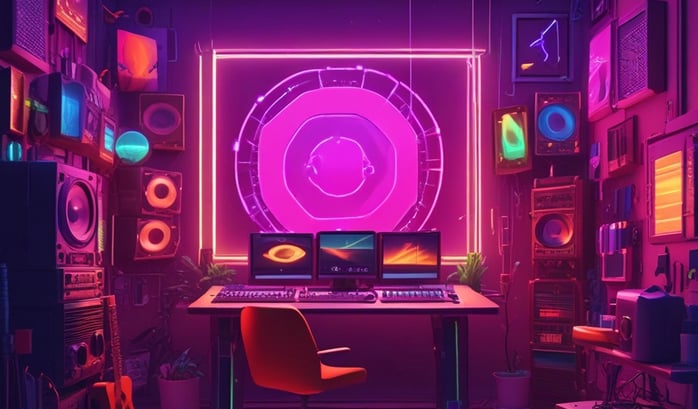Clean Studio, Clean Sound: How to Create a Minimal Home Studio That Inspires Creativity
Create a calm, inspiring space with this guide to building a minimal home music studio. Discover tips on gear, lighting, storage, and layout to boost creativity and productivity. Perfect for musicians, producers, and creators seeking a clean, clutter-free studio setup that enhances sound and supports a focused music-making environment.
Jenny Towers
5/15/20254 min read


Clean Studio, Clean Sound: How to Create a Minimal Home Studio That Inspires Creativity
There’s something quietly magical about walking into a space that feels effortless. The air seems lighter. Ideas flow more freely. When your music studio is clean, uncluttered, and designed with intention, your creativity has room to breathe.
Welcome to the world of minimalism—not just as a design trend, but as a philosophy that helps you focus less on clutter and more on craft.
In this article, we’ll explore how to create a minimal home studio that not only looks good but feels good—boosting productivity, calming your mind, and helping you capture your best ideas.
Why Minimalism Matters in a Music Studio
In a home studio, space is often limited. You may be tucked into a corner of a bedroom or working out of a spare room. It’s tempting to fill every surface with gear, cables, and audio knick-knacks—but more stuff doesn’t equal more creativity. In fact, it can smother it.
A minimal studio setup allows for:
Fewer distractions
More focus on sound
Improved workflow
A calming, intentional environment
Think of it like clearing the fog so the melody can come through.
1. Start With a Blank Slate
Minimalism starts by removing everything you don’t need. Imagine you’re designing a tiny spaceship for sound exploration—you can only bring the essentials.
Step 1: Take everything out of your current setup.
Step 2: Put back only what serves a purpose or brings you joy.
Ask yourself: Does this help me create better music?
That cracked MIDI controller you haven’t used in two years? Let it go.
That lava lamp shaped like a saxophone that flickers like a heartbeat when you play lo-fi beats? Keep it. That’s soul.
2. Prioritize Versatile Gear
Minimal doesn’t mean bare. It means intentional. Choose multi-functional gear that can serve multiple purposes.
Examples:
A Novation Launchkey for keys, MIDI control, and pads.
A Focusrite Scarlett 2i2: Compact, reliable audio interface with just enough I/O for most solo artists.
KRK Rokit 5s or Yamaha HS5s: Small but powerful monitors that don’t overwhelm your space.
If you’re a producer, opt for an all-in-one DAW controller like the Akai MPK Mini that saves space and keeps your workflow tight.
3. Desk Setup: Less is More
Your desk is command central. It should be clean, clear, and welcoming. Think of it like the cockpit of a creative aircraft. You don’t want to search under a pile of XLR cables every time you want to record a vocal.
Keep on your desk:
Your computer or laptop
Your audio interface
One MIDI controller or keyboard
Studio monitors (angled properly, of course)
A small plant or object that brings you joy (yes, it’s allowed)
Whimsical tip: Add a tiny bonsai tree or a ceramic llama that watches over your sessions like a stoic producer. Never underestimate the power of a studio mascot.
4. Hide the Mess with Smart Storage
Cables, microphones, and adapters will always be part of the game—but they don’t have to live in plain sight.
Storage ideas:
Use cable boxes or under-desk trays to hide wires.
Store small gear in labelled drawers or minimalist storage bins.
Mount floating shelves for headphones, hard drives, or audio tools.
Bonus whimsy: Label one drawer “Magic,” and keep only the weird, wonderful tools that spark experimentation—like a cassette recorder or toy piano.
5. Lighting Sets the Tone
Good lighting can shift your whole mood. Harsh overhead lights? Not the vibe. Go for warm, soft lighting to create a space that’s soothing and inspired.
Suggestions:
A desk lamp with adjustable color warmth
LED strip lights behind your desk or monitors
A salt lamp for natural glow and mythical ambiance
Optional enchantment: Hang fairy lights that pulse gently with the beat. Who says minimalism can’t be a little magical?
6. Use Color and Texture Sparingly
Minimal doesn’t mean sterile. A neutral color palette—think warm woods, whites, charcoals—creates a grounded feeling. Then, introduce just one or two accents: a patterned rug, a rich green plant, or a mustard-yellow pillow on your studio chair.
Sound meets style: Use acoustic foam panels in geometric patterns or custom colors to combine function with design.
7. Embrace Empty Space
Leave space on your walls. Leave space on your desk. Leave space in your schedule. Empty space invites ideas to arrive. It’s the canvas between the notes.
Creativity doesn’t always come from more—it often comes from room.
Final Thoughts: Let Your Studio Reflect Your Sound
A clean studio won’t write your next song. But it will invite it. It will whisper to your creativity, “There’s space for you here.” Whether your music is soft and ambient or bold and rhythmic, your environment should be a reflection of the sound you’re creating—and the energy you want to keep.
So pour a coffee, light that ceramic llama candle (yes, it’s real), and give your studio a cleanse. When you clean the space, you clear the noise. And from that stillness, the best music flows.
If you want to get a better understanding of what to do to increase this workflow or you just want some assurance that what you are doing is right and not going to destroy your music career, click here for some additional helpful tips.








